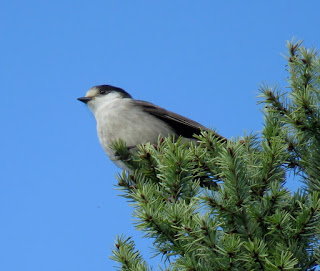December 2019 went by in a flash. Early in the month I joined my friends Alan and Thomas (visiting his parents, my new next-door neighbors, for the holidays) for a day trip to the South Jetty of the Siuslaw River in Florence.
It’s a good time of year for something odd to show up, but my favorite sighting from the day was this very confiding Wrentit.
My feeders became more and more popular as they were discovered by the neighborhood birds. I make my own peanut butter suet, and it was soon discovered by Dark-eyed Juncos, Northern Flickers, Townsend’s Warblers, Bushtits, and Starlings. To discourage the starlings I hung the feeder in a trap generously made for me by my friend Jeff Harding who had all the spare parts. All the native birds can either stick their head through the mesh (flickers), or easily go in and out like the Bushtits here.
There’s not a lot of brushy areas in the neighborhood, so I feel lucky to have had this White-throated Sparrow, which was hanging out with Golden-crowned Sparrows and Dark-eyed Juncos.
Then came Christmas Bird Count season, and I participated in four. First of the season was the Florence CBC, and I did the northern coastal section that included Lily Lake with Ramiro Aragon, a birder from Oaxaca with whom I had corresponded briefly 16 years ago but met only the first time, very coincidentally, last month.
The birding was productive, though nothing rare popped up for us. I did pause in the birding to take photos of this white coral fungus, Clavulina coralloides.
The next day was the Brownsville CBC, one that was started by Paul Adamus while I was still a student at OSU, but I had never had the chance to take part in it. I did the area around the little town of Crawfordsville in the outermost foothills of the Cascades with my friends Thomas and Torrey. While birding, we were stopped by a local who was curious about what we were up to, and John Marble ended up being a great local contact who knows birds, knows the area, and gave us access to private property with habitat.
Though he had hoped to show us a Barn Own in one of his barns, we instead found this Northern Pygmy-Owl (amazingly, my third in seven weeks) on his property.
With several days to continue my moving-in process and shaping up the yard, I began my plan of getting rid of the lawn in order to convert it to native plant and insect paradise. First, I ordered a truckload (five units, or 37.5 cubic yards) of fir bark mulch delivered to my driveway.
Then all the boxes from my moving plus a bunch of old science fair posters from my neighbor’s school were on hand to cover the lawn. I calculated four inches of the bark mulch will cover the entire lawn part of the yard. I just barely got started before my next CBC, Roseburg.
Sadly, it rained all day for the Roseburg CBC, which didn’t keep people from birding, but it did limit visibility and probably kept a few species from being detected (Hairy Woodpecker was missed, for example). I joined local birding Jim Houseman to cover Fords Pond, an amazing protected area holding the richest diversity of birds in the circle.
We ignored the rain and hiked to the top of the oak-covered hill west of the pond and found Western Bluebirds and Acorn Woodpeckers here. Our best bird of the day was a Cinnamon Teal (rare here in winter) in the small pond below Jim’s house.
Finally, I participated on the Dallas CBC for the first time in decades, and Caleb the compiler assigned me to hike to the highest elevations and parcels of public land in the Coast Range at the western edge of the circle. This was my favorite CBC of the season, thanks in part to the great weather (fog in the valley, sunny but a bit chilly up where I was). I hiked some 12 miles total, finding many Hutton’s Vireos, Wrentits, and countless Golden-crowned Kinglets. This Canada Jay was among several that I found.
My favorite discovery of the day was this shrub, Garrya fremontii. There are some south-facing slopes with shallow, rocky soil here, also hosting manzanita, and this appears to be a very isolated population, the farthest north in the Coast Range of Oregon. It’s much more common in the Siskiyous, Cascades, and south into California.
I had a nice quiet, Christmas with my dad and stepmom in Corvallis, and on the next day was supposed to be on my way to Brazil for my long-planned 50th birthday celebration at Cristalino Jungle Lodge – only my Eugene flight was canceled after many delays, and I ended up spending the night at home. So I ended up getting to Brazil just a day late, but fortunately I had planned to spend an extra 10 days there in advance of my big birthday bash (more on that in a later blog), helping my regular client Susanne with her third year of the Cristalino Fungi Project. Her husband Andreas joins her for their join vacation, and he greeted me at the floating dock with gin and tonics in hand.
I arrived on the 29th and in the last two days of 2019 took over 200 photos of an incredible diversity of fungi, plants, and invertebrates. One of the most exciting was on a night walk where I found this net-casting spider in the genus Deinopis, family Deinopidae. It hangs like this near the tree trunk waiting for something like a cricket or cockroach to walk by and then uses four feet to throw the net at the prey, something like the way a fisherman might cast a net over a school of fish.





















No comments:
Post a Comment